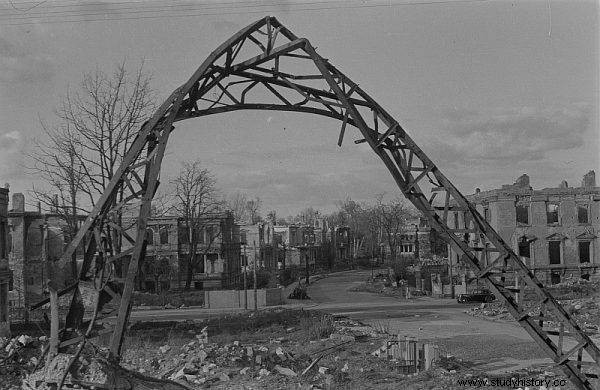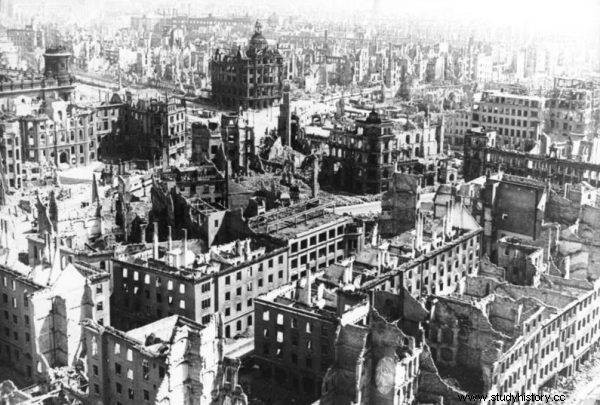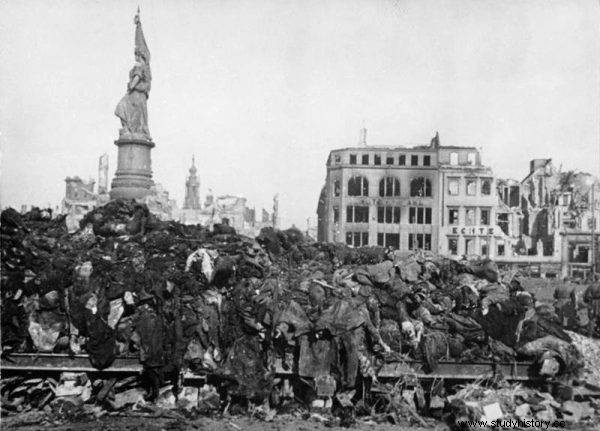A large part of the city was razed to the ground. Tens of thousands of civilians died. This is a grim record of the Allied bombing of Dresden in February 1945. There are still discussions as to whether it was a war crime, an act of genocide, or ... a necessary evil?
The result of the hostilities that had been going on for over five years was a doomed one. The Third Reich would soon cease to exist. In February 1945, probably no one (well, maybe apart from Hitler and a group of his staunchest supporters) believed that Germany could still win this war. Trapped in the claws of the Allied forces on the one hand and the Red Army on the other, they had no chance to get up from their knees.
It was then that the command of the Allied Air Force decided to launch an unprecedented bombing that was to wipe out Dresden. The city had no air defense. It was neither militarily nor strategically relevant. Piotr Zychowicz in his latest book "Allies" states directly:" It was an act of sadism, tormenting the defeated opponent . To this day, the destruction of Dresden is one of the symbols of dark human nature and the nightmare of war. ”
Death List
The sentence on the city was handed down as early as November 1944, when it was placed on the infamous "death list" of the Marshal of the Royal Air Force, Arthur Harris, not without reason called the Butcher. He planned to raze to the ground 60 largest metropolises of the Third Reich. When the carpet raids he initiated began, the Germans were shocked.

The Allies have turned Dresden into a sea of ruin and debris.
" The German civilian population has had no direct experience with hostilities . Germany was not occupied, as other countries were occupied by Germany, so people did not have this awareness of what occupation means "- explained historian prof. Bogdan Musiał.
The extermination of Dresden began on the eve of Valentine's Day 1945. Officially, the purpose of the bombing was to destroy the Dresden railway junction. It's just that the tracks were only slightly damaged and they were quickly restored to their original state. Contrary to the old city, which was almost completely left in ruins.
Bright as during the day
On the night of February 13-14, 1945, almost 800 British Avro Lancaster bombers set off over the center of Dresden. They launched the attack in two waves. This is how the tragedy that took place at that time was reported in his "Diary" by a direct witness of those events, the German Jew Victor Klemperer:
Very quickly we heard the deeper and louder rumble of incoming planes. The light went out, there was a boom nearby… A pause to catch your breath. People are kneeling between the chairs. Someone is moaning, someone is crying. They are flying again, death is hitting the throat again , another explosion.

The text was created, among others based on the latest book by Piotr Zychowicz, Alianci. Politically Incorrect Tales V, which has just been released by the Rebis publishing house.
I don't know how many times this has been repeated. Suddenly the basement window (the back wall of the building, opposite the entrance) opened - it was bright as day outside. Someone was shouting, "Incendiary bomb, we must extinguish!" Two people were attracted to the fire pump, you could hear them working. More explosions followed, but not in the courtyard, somewhere further (...). It was as bright as day outside.
As the Allies mainly used incendiary bombs for the attack, the city streets were engulfed in massive fires that led to a firestorm.
Hell on Earth
What happened next can be called a little apocalypse. As Włodzimierz Kalicki wrote:
The real hell on earth begins - a firestorm. A group of houses burning at the same time throws a column of fire, smoke and terribly hot air many hundreds of meters upwards. At the bottom, it sucks in cool air from the neighborhood with incredible force. It begins to circle around the fire at great speed, like a tornado. It kidnaps everything. People take to the air and disappear in a giant pillar of fire.

Dresden after the Allied air raids
As the wall of flames sucked in ambient air, oxygen was running out. According to some estimates, almost three-quarters of the casualties of the Allied air raids on Dresden may have died as a result of suffocation.
British airmen striking in the second wave had a difficult task - they had to drop bombs blindly because the city was covered with a gigantic blanket of smoke. Włodzimierz Kalicki added:“Local firestorms are coalescing, a gigantic firestorm is created. It sucks in thousands, tens of thousands of people . The city turns into a torch 4 km high. Only the strategic railway junction, the formal reason for the bombing, is practically undamaged. ”
Balance of crime
The work of destruction was carried out on February 14 by 311 American Boeing B-17 Flying Fortress bombers. The old town was ruined. Flames consumed hundreds of priceless monuments, museum and library collections, archives and works of art. And also - above all - residential houses. Dresden turned into a desert filled with smoke from dying fires. Piotr Zychowicz in "Aliants" describes:
Successive waves of bombers that flew over the city crushed buildings - along with the people living in them - like a mighty jackhammer. 4,000 tons of blasting and incendiary bombs rained down on the city with a terrible roar, sweeping 6.5 square kilometers of Dresden off the ground. There were 650,000 incendiary bombs alone! For comparison, throughout World War II, the Luftwaffe destroyed 2.4 square kilometers of London .

The air raids on Dresden took from 18,000 to as much as 25,000 casualties.
Over the years, historians have argued over how many casualties the raids took. The boldest estimate was up to half a million dead. Nazi propaganda estimated the loss of people at around 200,000. Later, more modest numbers were given - 35,000 (in 1965), and finally - in 2011 - from 18,000 to 25,000 (according to the findings of the commission appointed by the Saxon authorities).
Until today, however, researchers do not agree on how to assess the Allied decision to launch these attacks on the eve of the surrender of the Third Reich. Some consider carpet raids on Dresden and other German cities as a war crime . Some believe it was evil, but necessary to break the enemy's morale.
Finally, there are those who consider the bombing to be a justified retaliation. Like RAF Marshal Arthur "Butcher" Harris, who, when asked for a moral evaluation of these actions, was supposed to say, "They sowed the wind, so now let them pick up the storm."
